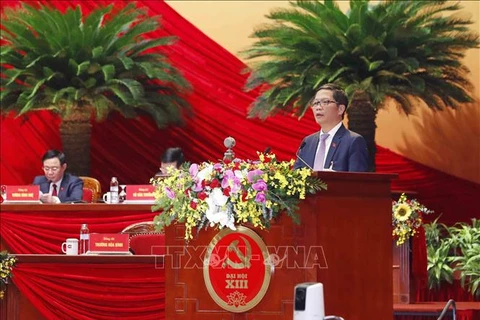 Vietnam ranks the fifth among the ASEAN member states in the UN Industrial Development Organisation (UNIDO)’s Competitive Industrial Performance Index (CIP). (Photo: VietnamPlus)
Vietnam ranks the fifth among the ASEAN member states in the UN Industrial Development Organisation (UNIDO)’s Competitive Industrial Performance Index (CIP). (Photo: VietnamPlus)Hanoi (VNA) – Industry was the fastest growing sector and the largest contributor to Vietnam’s export revenue over the last decade, making up roughly 30 percent of the annual GDP, Minister of Industry and Trade Tran Tuan Anh told the on-going 13th National Party Congress on January 28 morning.
This made Vietnam the world’s 22nd largest exporter in 2019, from the 50th in 2010, Anh said, adding that industry has been serving as a key driver of the economy, helping the country gain a good reputation in the global supply chain.
In 2019, Vietnam climbed 16 places to rank the 42nd from the 58th in 2009 in the UN Industrial Development Organisation (UNIDO)’s Competitive Industrial Performance Index (CIP). The country was placed the fifth among the ASEAN member states.
Various industrial sub-sectors, he continued, have grown as key to the economy, namely oil and gas; electronics, telecommunications and information technology; metallurgy, and iron and steel production; cement and construction materials; textile-garment and footwear; mechanical engineering, automobiles and motorcycles; ect., thus laying an important foundation for long-term growth and ramping up the national industrialisation and modernisation.
The minister highlighted processing and manufacturing as the main growth engine of the entire industry, citing the sub-sector expanding 5.82 percent last year. Its contribution to the GDP increased over the past 10 years, from 13 percent in 2010 to around 16.7 percent in 2020.
Greater attention has also been paid to developing supporting industries, particularly in key sectors of textile-garment, footwear, electronics, agricultural processing. This has helped shape the country’s supporting industry ecosystem and increase the local content in products made in Vietnam.
 Minister of Industry and Trade Tran Tuan Anh delivers a remark at the 13th National Party Congress on January 28 morning. (Photo: VietnamPlus)
Minister of Industry and Trade Tran Tuan Anh delivers a remark at the 13th National Party Congress on January 28 morning. (Photo: VietnamPlus)Processed goods accounted for 85 percent of the total export revenue in 2020, up from 65 percent in 2016, he said. For high-tech products, the figure was 49.8 percent last year, compared to 44.3 percent in 2016.
He went on to say the country has seen not only the increasing presence of international corporations and multinationals but also a rise of domestic manufacturers, notably telecom group Viettel, Vietnam’s largest conglomerate VinGroup, Truong Hai Auto Corporation (THACO), automaker Thanh Cong, and steel maker Hoa Phat, that provides a strong base for the domestic supporting industry and sets the scene for the country to climb up in the global supply chain.
Vietnam’s industry, however, is mainly focusing on the low value-added stage of production and there has been a lack of linkage inside itself and with other sectors, and this may cause unsustainable development, Anh warned.
Most of the local firms engage in outsourcing services and product assembly, only few can participate in high value-added activities, such as research and development, product design, marketing, distribution, customer care and manufacturing of materials, equipment and machinery.
Notably, FDI firms remain the main engine of Vietnam’s industry and foreign trade, making up about 70 percent of the national export turnover, he said, noting that it has resulted from the weak link between FDI and domestic enterprises in the supply chain and the latter’s lack of competitiveness.
The minister called for more efforts to restructure and enhance capacity for domestic firms, especially helping them promote digital transformation and apply technology.
Regarding foreign direct investment attraction, he emphasised the need to promote Vietnam’s competitive advantages in terms of worker skills and innovation, rather than natural resources, unskilled labour or incentives which are poised as unsustainable and short-term./.

























